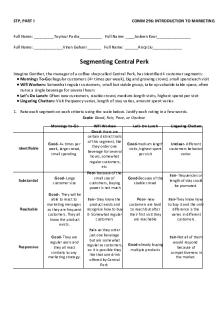Segmenting Central Perk PDF

| Title | Segmenting Central Perk |
|---|---|
| Author | Viren Gehani |
| Course | Introduction To Marketing |
| Institution | The University of British Columbia |
| Pages | 2 |
| File Size | 114.6 KB |
| File Type | |
| Total Downloads | 9 |
| Total Views | 149 |
Summary
Group In-class assignment ...
Description
STP, PART I
COMM 296: INTRODUCTION TO MARKETING
Full Name: _________Taymur Pasha__________ Full Name: ____Jasleen Kaur_______________ Full Name: _____________Viren Gehani ______ Full Name: ______Anqi Liu_____________
Segmenting Central Perk Imagine Gunther, the manager of a coffee shop called Central Perk, has identified 4 customer segments: ● Mornings To-Go: Regular customers (4+ times per week), big and growing crowd, small spend each visit ● Wifi Workers: Somewhat regular customers, small but stable group, take up valuable table space, often nurse a single beverage for several hours ● Let’s Do Lunch: Often new customers, sizable crowd, medium-length visits, highest spend per visit ● Lingering Chatters: Visit frequency varies, length of stay varies, amount spent varies 1. Rate each segment on each criteria using the scale below. Justify each rating in a few words. Scale: Good, Fair, Poor, or Unclear Mornings To-Go
Wifi Workers Good- there are certain distinct traits of this segment, like they order one beverage for several hours, somewhat regular customers, etc
Let's Do Lunch
Lingering Chatters
Good-medium length visits, highest spent per visit
Unclear- different customers behavior varies
Identifiable
Good- 4+ times per week, large crowd, small spending
Substantial
Good- Large customer size
Poor- because of the small size of customers, buying power is not much
Good-Because of the sizable crowd
Fair- frequencies or length of stay could be promoted.
Reachable
Good-. They will be able to react to marketing messages as they are frequent customers. They all know the product exists.
Fair- they know the product exists and recognise how to buy it- Somewhat regular customers
Poor- new customers are hard to reach but after their first visit they are reachable
Fair-They know how to buy it and the only difference is the varies in different customers.
Good- They are regular users and they all react similarly to any marketing strategy.
Fair- as they order just one beverage but are somewhat regular as customers, so it is possible they like that one drink offered by Central Perk
Good-already buying multiple products
Fair-Not all of them would respond because of competitiveness in the market.
Responsive
Profitable
Fair- Visit often but spend less resulting in average profitability.
Poor- as these regular customers spend most of their time sipping on a single beverage for hours, so loss of revenue (valuable space taken up)
Good- they spend the highest per visit although they visit less frequently
Poor- they have volatile profitability because of the random time customers would spend.
2. Based on your answers in the table above, which segment(s) should Central Perk target? Why? One segment that Central Perk could target would be the “Mornings to Go” crowd. This is the largest customer segment and they visit very often (4+ times a week). They are identifiable, substantial, reachable, and responsive. Currently they are not that profitable as they don’t spend much however a successful marketing strategy could convince these regulars to spend more on each visit, increasing profitability. They could for example launch a new more premium product that replaces what the regulars normally get and market it to them. Central Perk should target the “Let's Do Lunch” segment. The main reason is that this segment has the highest profitability, as they have the highest expenditure, so this proves to be an opportunity for marketers. By targeting them through a Micromarketing, Central perk can create their menu in accordance with their purchasing behavior- highest spent, medium length visits (opportunity for more beverages to be sold, per customer- which will help retain these customers in the long run. As they visit less frequently, not much of these revenues are turned to long-term profit; however targeting them through Micromarketing could be a key factor that helps them do this as they can tailor needs to individual customers more easily, which will help them reach the audience in a better, personalised way, which is easier to achieve for a single coffee shop....
Similar Free PDFs

Segmenting Central Perk
- 2 Pages

ANALISIS SEGMENTING PT TIKI JNE
- 6 Pages

Central dogma
- 4 Pages

Central Park Five Essay
- 7 Pages

Measures of Central Tendency
- 14 Pages

Central transport assignment
- 2 Pages

Caso Central Lechera Asturiana
- 3 Pages

Medidas DE Tendencia Central
- 9 Pages

Junta central de contadores
- 3 Pages

Central Administration of Akbar
- 6 Pages

Presion Venosa Central
- 4 Pages

Central Dogma Grade 12
- 2 Pages

Trabajo limite central
- 15 Pages
Popular Institutions
- Tinajero National High School - Annex
- Politeknik Caltex Riau
- Yokohama City University
- SGT University
- University of Al-Qadisiyah
- Divine Word College of Vigan
- Techniek College Rotterdam
- Universidade de Santiago
- Universiti Teknologi MARA Cawangan Johor Kampus Pasir Gudang
- Poltekkes Kemenkes Yogyakarta
- Baguio City National High School
- Colegio san marcos
- preparatoria uno
- Centro de Bachillerato Tecnológico Industrial y de Servicios No. 107
- Dalian Maritime University
- Quang Trung Secondary School
- Colegio Tecnológico en Informática
- Corporación Regional de Educación Superior
- Grupo CEDVA
- Dar Al Uloom University
- Centro de Estudios Preuniversitarios de la Universidad Nacional de Ingeniería
- 上智大学
- Aakash International School, Nuna Majara
- San Felipe Neri Catholic School
- Kang Chiao International School - New Taipei City
- Misamis Occidental National High School
- Institución Educativa Escuela Normal Juan Ladrilleros
- Kolehiyo ng Pantukan
- Batanes State College
- Instituto Continental
- Sekolah Menengah Kejuruan Kesehatan Kaltara (Tarakan)
- Colegio de La Inmaculada Concepcion - Cebu


